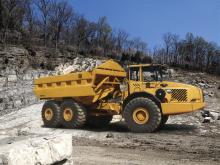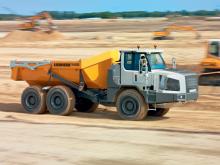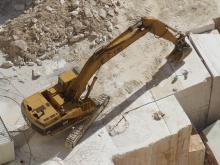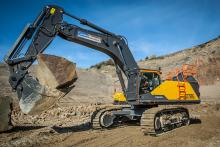Addition of a Liebherr dozer to the equipment fleet of one UK quarry is helping to improve efficiency. Dan Gilkes reports
A dimensional sandstone quarry in Yorkshire, UK, has changed its method of moving overburden. By using
Johnsons Wellfield Quarries, part of the Yorkshire-based
The stone is broken out from the face by a Liebherr R964 excavator equipped with a single tooth ripper. Each block of stone is catalogued and numbered ready for the production site. Blocks that are too large to haul are cut by drilling through the block and then split using wedges.
A
Traditionally the company has used excavators and dump trucks to move the 2-10m of overburden from above the stone. The truck and excavator combination was then used to bring the soils back onto the site to reinstate as the quarry face moved forwards.
The company decided to change this method of operation, opting instead for a single large dozer armed with a powerful ripper, to strip the overburden. The same machine is then used to carry out the initial respreading operation of cover, prior to full reinstatement using smaller machinery.
"Instead of having three large excavators and a fleet of dump trucks we could have one large dozer with one man," said Crosland quarry manager Shaun Berry. "It was better for the environment and offered a lower cost solution." The company is no stranger to the Liebherr brand, currently running seven Liebherr excavators, including three R954s, an R964 and an R984. "We had a smaller LR622 tracked shovel before from Liebherr and that opened our eyes to hydrostatic drive," said Berry.
"It was a marvellous machine, and that made us listen to Liebherr about a big dozer." And he means big. The company invested in the first PR764 Litronic in the UK, which is Liebherr's biggest tractor and one of the largest hydrostatically driven machines in the world.
"We had a Cat D9 on hire at the time, but now the Liebherr has taken over. It's great, it really is a good machine. We proved that the Liebherr is the better of the two for this site," said Berry.
"It's better for fuel consumption, for comfort, for pushing ability, everything. It's far better than the way we used to move overburden." The PR764 Litronic is among the fourth generation of Liebherr's crawler tractors. Powered by a 16.2litre common rail V8 Tier 3 diesel engine, the tractor has a healthy 422hp on tap at just 1,600rpm. As the engine is driving hydraulic motors, with no torque converter or manual gearbox, engine revs can be maintained as near constant as possible, despite fluctuating demand. This allows Liebherr to tailor the driveline to run at optimum engine revs for maximum fuel efficiency, also contributing to reduced exhaust emissions.
An additional benefit of the hydrostatic driveline is the normally incompatible combination of a low centre of gravity with high ground clearance. The machine can also turn almost on the spot, allowing rapid relocation of the ripper when tearing out new ground.
The result is strong pushing and pulling power. At 1.5km/h the PR764 provides 610kN of drawbar pull. There is a choice of blades and ripper shanks to suit the terrain and the operation. The semi-U blade has a capacity of 14m3, while the full U blade can handle up to 17m3 of spoil. Liebherr claims to have optimised the penetration and rolling behaviour of the blades to maximise carrying capacity, and the dozer has no trouble pushing a full blade when spreading overburden material on the finished area of the quarry.










